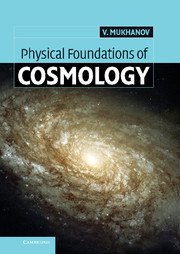Book contents
- Frontmatter
- Contents
- Foreword by Professor Andrei Linde
- Preface
- Acknowledgements
- Units and conventions
- Part I Homogeneous isotropic universe
- 1 Kinematics and dynamics of an expanding universe
- 2 Propagation of light and horizons
- 3 The hot universe
- 4 The very early universe
- 5 Inflation I: homogeneous limit
- Part II Inhomogeneous universe
- Bibliography
- Index
5 - Inflation I: homogeneous limit
from Part I - Homogeneous isotropic universe
Published online by Cambridge University Press: 05 September 2012
- Frontmatter
- Contents
- Foreword by Professor Andrei Linde
- Preface
- Acknowledgements
- Units and conventions
- Part I Homogeneous isotropic universe
- 1 Kinematics and dynamics of an expanding universe
- 2 Propagation of light and horizons
- 3 The hot universe
- 4 The very early universe
- 5 Inflation I: homogeneous limit
- Part II Inhomogeneous universe
- Bibliography
- Index
Summary
Matter is distributed very homogeneously and isotropically on scales larger than a few hundred megaparsecs. The CMB gives us a “photograph” of the early universe, which shows that at recombination the universe was extremely homogeneous and isotropic (with accuracy ∼ 10−4) on all scales up to the present horizon. Given that the universe evolves according to the Hubble law, it is natural to ask which initial conditions could lead to such homogeneity and isotropy.
To obtain an exhaustive answer to this question we have to know the exact physical laws which govern the evolution of the very early universe. However, as long as we are interested only in the general features of the initial conditions it suffices to know a few simple properties of these laws. We will assume that inhomogeneity cannot be dissolved by expansion. This natural surmise is supported by General Relativity (see Part II of this book for details). We will also assume that nonperturbative quantum gravity does not play an essential role at sub-Planckian curvatures. On the other hand, we are nearly certain that nonperturbative quantum gravity effects become very important when the curvature reaches Planckian values and the notion of classical spacetime breaks down. Therefore we address the initial conditions at the Planckian time ti = tPl ∼ 10−43 s.
In this chapter we discuss the initial conditions problem we face in a decelerating universe and show how this problem can be solved if the universe undergoes a stage of the accelerated expansion known as inflation.
- Type
- Chapter
- Information
- Physical Foundations of Cosmology , pp. 226 - 262Publisher: Cambridge University PressPrint publication year: 2005
- 1
- Cited by



